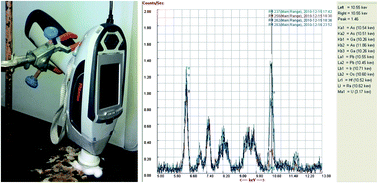The technique of diffusive gradients in thin films (DGT) is often employed to quantify labile metals in situ; however, it is a challenge to perform the measurements in-field. This study evaluated the capability of field-portable X-ray fluorescence (FP-XRF) to swiftly generate elemental speciation information with DGT. Biologically available metal ions in environmental samples passively preconcentrate in the thin films of DGT devices, providing an ideal and uniform matrix for XRF nondestructive detection. Strong correlation coefficients (r > 0.992 for Mn, Cu, Zn, Pb and As) were obtained for all elements during calibration. The limits of quantitation (LOQ) for the investigated elements of FP-XRF on DGT devices are 2.74 for Mn, 4.89 for Cu, 2.89 for Zn, 2.55 for Pb, and 0.48 for As (unit: μg cm−2). When Pb and As co-existed in the solution trials, As did not interfere with Pb detection when using Chelex-DGT. However, there was a significant enhancement of the Pb reading attributed to As when ferrihydrite binding gels were tested, consistent with Fe-oxyhydroxide surfaces absorbing large quantities of As. This study demonstrates the value of the FP-XRF technique to rapidly and nondestructively detect the metals accumulated in DGT devices, providing a new and simple diagnostic tool for on-site environmental monitoring of labile metals/metalloids.

You have access to this article
 Please wait while we load your content...
Something went wrong. Try again?
Please wait while we load your content...
Something went wrong. Try again?


 Please wait while we load your content...
Please wait while we load your content...